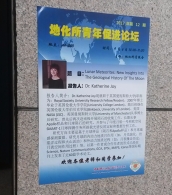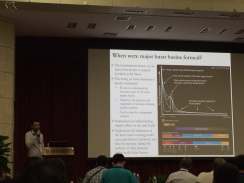
XiaoJia at the lunar exploration meeting in Beijing
In 2016 we had a visiting student Xiaojia Zeng who was funded by the Chinese Academy of Sciences to come to Manchester for six months and study in our group. He is based in the Lunar and Planetary Science Center at the Institute of Geochemistry in Guiyang (south west China) and is working for a PhD on both lunar meteorites and chondritic meteorites that have been found in China.
Now I have had an opportunity to return the visit and I am currently over in China in Guiyang to discuss research they have been undertaking on a wide range of topics from meteorites, to solar wind experiments, and modelling of the lunar magma ocean. I was able to present a talk about the research I do in Manchester about lunar meteorites, although I have to apologise that I did the talk in English, rather than Manderin (sadly I have only picked up a few words!). I have met many of the masters and PhD students who work in the group and have been made very welcome by the group leaders and my hosts Dr Shijie Li and Xiaojia Zeng.

Moon talk!
The city of Guiyang, home to some 5 million people, is undergoing an amazing amount of regional development and sits in a beautiful karst landscape of limestone wooded hills and rivers. The group at the Institute of Geochemistry is based in a very modern complex of buildings that also host researchers specializing in ore geology and environmental geochemistry. They have a fantastic array of labs and analytical instrumentation from experimental petrology and high pressure systems, isotopic wet chemistry labs to noble gas analysis and some unique ion implantation instruments.

CAS Institute for Geochemisty

Group member Romain discussing lunar chronology with Chinese and European lunar scientists
I am also here to learn more about China’s exciting lunar mission exploration programme – you can find out more about these activities by reading Xiaojia’s previous E&SS blog post . Next year the Chang’e 5 mission will return samples to Earth from a lava field area called Mons Rumker on the northern nearside of the Moon. This is very exciting for the worldwide lunar community as the last time Moon rocks were brought back to Earth was in 1976 when the Luna 24 mission visited Mare Crisium! Before travelling to Guiyang, I was in Beijing with several other European lunar scientists to discuss opportunities for scientific collaboration on the mission and future exploration efforts – see this article for more details. I have very much enjoyed my research visit to China so far, and look forward to future lunar and meteorite research collaborations.

A visit to the noble gas labs at the Chinese Academy of Sciences in Beijing
We are now off to a meteorite conference at Duke University close to Shanghai and I will post another blog from there soon about Chinese recovered meteorites.
—————————
Many thanks the Chinese Academy of Sciences for assisting with my visit and to everyone I have have met who has made me feel very welcome.


Pingback: Meteorites in China | Earth & Solar System
Pingback: New group paper about a recently discovered lunar meteorite | Earth & Solar System